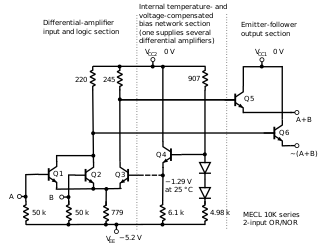Related Research Articles
In cryptography, a brute-force attack consists of an attacker submitting many passwords or passphrases with the hope of eventually guessing correctly. The attacker systematically checks all possible passwords and passphrases until the correct one is found. Alternatively, the attacker can attempt to guess the key which is typically created from the password using a key derivation function. This is known as an exhaustive key search. This approach doesn't depend on intellectual tactics; rather, it relies on making several attempts.

In electronics, emitter-coupled logic (ECL) is a high-speed integrated circuit bipolar transistor logic family. ECL uses an overdriven bipolar junction transistor (BJT) differential amplifier with single-ended input and limited emitter current to avoid the saturated region of operation and the resulting slow turn-off behavior. As the current is steered between two legs of an emitter-coupled pair, ECL is sometimes called current-steering logic (CSL), current-mode logic (CML) or current-switch emitter-follower (CSEF) logic.
In logic circuits, the Toffoli gate, also known as the CCNOT gate (“controlled-controlled-not”), invented by Tommaso Toffoli, is a CNOT gate with two control qubits and one target qubit. That is, the target qubit will be inverted if the first and second qubits are both 1. It is a universal reversible logic gate, which means that any classical reversible circuit can be constructed from Toffoli gates.

In quantum information theory, a quantum circuit is a model for quantum computation, similar to classical circuits, in which a computation is a sequence of quantum gates, measurements, initializations of qubits to known values, and possibly other actions. The minimum set of actions that a circuit needs to be able to perform on the qubits to enable quantum computation is known as DiVincenzo's criteria.

Rolf William Landauer was a German-American physicist who made important contributions in diverse areas of the thermodynamics of information processing, condensed matter physics, and the conductivity of disordered media. Born in Germany, he emigrated to the U.S. in 1938, obtained a Ph.D. in physics from Harvard in 1950, and then spent most of his career at IBM.
The structured program theorem, also called the Böhm–Jacopini theorem, is a result in programming language theory. It states that a class of control-flow graphs can compute any computable function if it combines subprograms in only three specific ways. These are
- Executing one subprogram, and then another subprogram (sequence)
- Executing one of two subprograms according to the value of a boolean expression (selection)
- Repeatedly executing a subprogram as long as a boolean expression is true (iteration)
Reversible computing is any model of computation where the computational process, to some extent, is time-reversible. In a model of computation that uses deterministic transitions from one state of the abstract machine to another, a necessary condition for reversibility is that the relation of the mapping from states to their successors must be one-to-one. Reversible computing is a form of unconventional computing.

The Fredkin gate is a computational circuit suitable for reversible computing, invented by Edward Fredkin. It is universal, which means that any logical or arithmetic operation can be constructed entirely of Fredkin gates. The Fredkin gate is a circuit or device with three inputs and three outputs that transmits the first bit unchanged and swaps the last two bits if, and only if, the first bit is 1.

The POWER6 is a microprocessor developed by IBM that implemented the Power ISA v.2.05. When it became available in systems in 2007, it succeeded the POWER5+ as IBM's flagship Power microprocessor. It is claimed to be part of the eCLipz project, said to have a goal of converging IBM's server hardware where practical.
Static timing analysis (STA) is a simulation method of computing the expected timing of a synchronous digital circuit without requiring a simulation of the full circuit.
Landauer's principle is a physical principle pertaining to the lower theoretical limit of energy consumption of computation. It holds that an irreversible change in information stored in a computer, such as merging two computational paths, dissipates a minimum amount of heat to its surroundings.
The mathematical expressions for thermodynamic entropy in the statistical thermodynamics formulation established by Ludwig Boltzmann and J. Willard Gibbs in the 1870s are similar to the information entropy by Claude Shannon and Ralph Hartley, developed in the 1940s.
Unconventional computing is computing by any of a wide range of new or unusual methods.
Arthur Lee Samuel was an American pioneer in the field of computer gaming and artificial intelligence. He popularized the term "machine learning" in 1959. The Samuel Checkers-playing Program was among the world's first successful self-learning programs, and as such a very early demonstration of the fundamental concept of artificial intelligence (AI). He was also a senior member in the TeX community who devoted much time giving personal attention to the needs of users and wrote an early TeX manual in 1983.
Reverse computation is a software application of the concept of reversible computing.
Norman H. Margolus is a Canadian-American physicist and computer scientist, known for his work on cellular automata and reversible computing. He is a research affiliate with the Computer Science and Artificial Intelligence Laboratory at the Massachusetts Institute of Technology.

A reversible cellular automaton is a cellular automaton in which every configuration has a unique predecessor. That is, it is a regular grid of cells, each containing a state drawn from a finite set of states, with a rule for updating all cells simultaneously based on the states of their neighbors, such that the previous state of any cell before an update can be determined uniquely from the updated states of all the cells. The time-reversed dynamics of a reversible cellular automaton can always be described by another cellular automaton rule, possibly on a much larger neighborhood.
IBM POWER is a reduced instruction set computer (RISC) instruction set architecture (ISA) developed by IBM. The name is an acronym for Performance Optimization With Enhanced RISC.
IBM Quantum Platform is an online platform allowing public and premium access to cloud-based quantum computing services provided by IBM. This includes access to a set of IBM's prototype quantum processors, a set of tutorials on quantum computation, and access to an interactive textbook. As of February 2021, there are over 20 devices on the service, six of which are freely available for the public. This service can be used to run algorithms and experiments, and explore tutorials and simulations around what might be possible with quantum computing.
In quantum computing, quantum supremacy or quantum advantage is the goal of demonstrating that a programmable quantum computer can solve a problem that no classical computer can solve in any feasible amount of time, irrespective of the usefulness of the problem. The term was coined by John Preskill in 2012, but the concept dates to Yuri Manin's 1980 and Richard Feynman's 1981 proposals of quantum computing.
References
- ↑ Landauer, Rolf (1961), "Irreversibility and heat generation in the computing process", IBM Journal of Research and Development, 5 (3): 183–191, doi:10.1147/rd.53.0183, MR 0134833
- ↑ Bennett, Charles H. (1973), "Logical reversibility of computation", IBM Journal of Research and Development, 17 (6): 525–532, doi:10.1147/rd.176.0525, MR 0449020